Emanuele La Malfa
Large Language Models Miss the Multi-Agent Mark
May 27, 2025Abstract:Recent interest in Multi-Agent Systems of Large Language Models (MAS LLMs) has led to an increase in frameworks leveraging multiple LLMs to tackle complex tasks. However, much of this literature appropriates the terminology of MAS without engaging with its foundational principles. In this position paper, we highlight critical discrepancies between MAS theory and current MAS LLMs implementations, focusing on four key areas: the social aspect of agency, environment design, coordination and communication protocols, and measuring emergent behaviours. Our position is that many MAS LLMs lack multi-agent characteristics such as autonomy, social interaction, and structured environments, and often rely on oversimplified, LLM-centric architectures. The field may slow down and lose traction by revisiting problems the MAS literature has already addressed. Therefore, we systematically analyse this issue and outline associated research opportunities; we advocate for better integrating established MAS concepts and more precise terminology to avoid mischaracterisation and missed opportunities.
Fixed Point Explainability
May 18, 2025Abstract:This paper introduces a formal notion of fixed point explanations, inspired by the "why regress" principle, to assess, through recursive applications, the stability of the interplay between a model and its explainer. Fixed point explanations satisfy properties like minimality, stability, and faithfulness, revealing hidden model behaviours and explanatory weaknesses. We define convergence conditions for several classes of explainers, from feature-based to mechanistic tools like Sparse AutoEncoders, and we report quantitative and qualitative results.
Language Models Are Implicitly Continuous
Apr 04, 2025Abstract:Language is typically modelled with discrete sequences. However, the most successful approaches to language modelling, namely neural networks, are continuous and smooth function approximators. In this work, we show that Transformer-based language models implicitly learn to represent sentences as continuous-time functions defined over a continuous input space. This phenomenon occurs in most state-of-the-art Large Language Models (LLMs), including Llama2, Llama3, Phi3, Gemma, Gemma2, and Mistral, and suggests that LLMs reason about language in ways that fundamentally differ from humans. Our work formally extends Transformers to capture the nuances of time and space continuity in both input and output space. Our results challenge the traditional interpretation of how LLMs understand language, with several linguistic and engineering implications.
Understanding the Logical Capabilities of Large Language Models via Out-of-Context Representation Learning
Mar 13, 2025Abstract:We study the capabilities of Large Language Models (LLM) on binary relations, a ubiquitous concept in math employed in most reasoning, math and logic benchmarks. This work focuses on equality, inequality, and inclusion, along with the properties they satisfy, such as ir/reflexivity, a/symmetry, transitivity, and logical complexity (e.g., number of reasoning ``hops''). We propose an alternative to in-context learning that trains only the representations of newly introduced tokens, namely out-of-context representation learning. This method mitigates linguistic biases already present in a model and, differently from in-context learning, does not rely on external information or illustrations. We argue out-of-context representation learning as a better alternative to in-context learning and fine-tuning to evaluate the capabilities of LLMs on logic tasks that are the building blocks of more complex reasoning benchmarks.
When Claims Evolve: Evaluating and Enhancing the Robustness of Embedding Models Against Misinformation Edits
Mar 05, 2025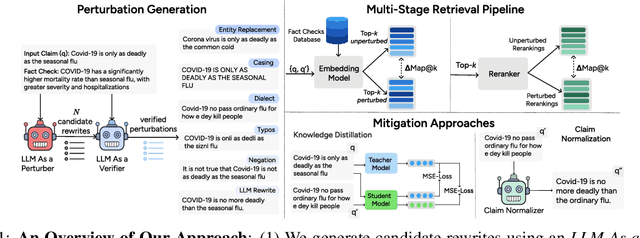

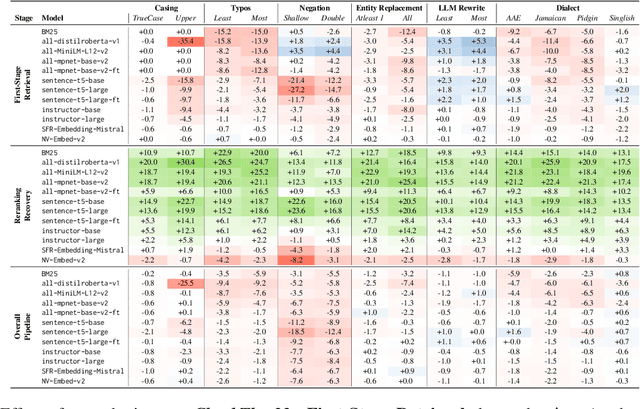
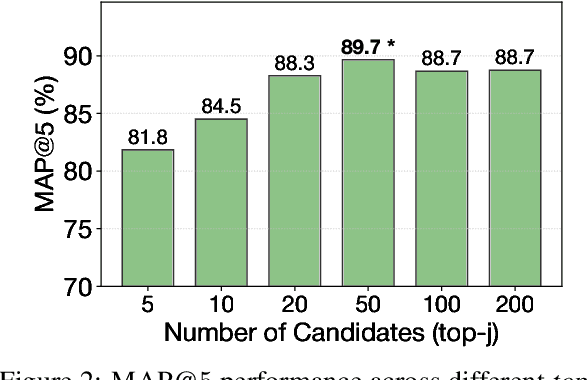
Abstract:Online misinformation remains a critical challenge, and fact-checkers increasingly rely on embedding-based methods to retrieve relevant fact-checks. Yet, when debunked claims reappear in edited forms, the performance of these methods is unclear. In this work, we introduce a taxonomy of six common real-world misinformation edits and propose a perturbation framework that generates valid, natural claim variations. Our multi-stage retrieval evaluation reveals that standard embedding models struggle with user-introduced edits, while LLM-distilled embeddings offer improved robustness at a higher computational cost. Although a strong reranker helps mitigate some issues, it cannot fully compensate for first-stage retrieval gaps. Addressing these retrieval gaps, our train- and inference-time mitigation approaches enhance in-domain robustness by up to 17 percentage points and boost out-of-domain generalization by 10 percentage points over baseline models. Overall, our findings provide practical improvements to claim-matching systems, enabling more reliable fact-checking of evolving misinformation.
Code Simulation as a Proxy for High-order Tasks in Large Language Models
Feb 05, 2025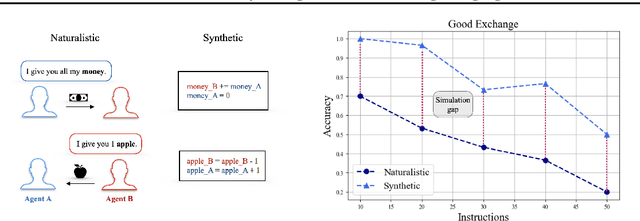

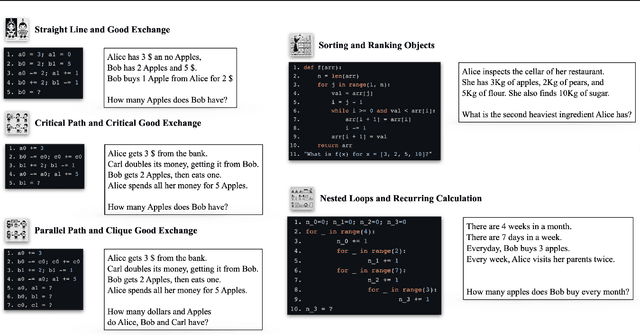
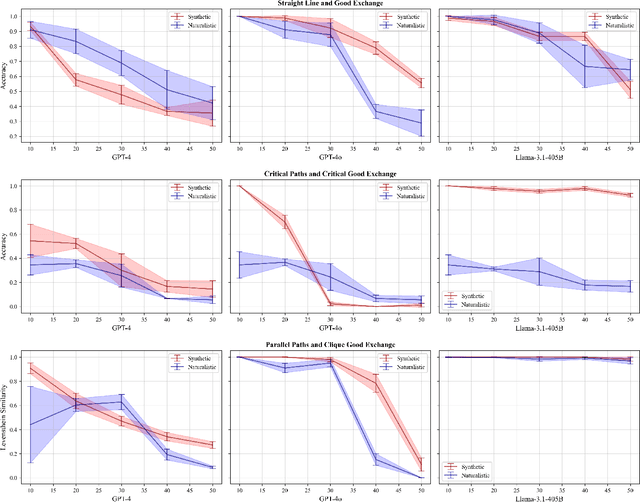
Abstract:Many reasoning, planning, and problem-solving tasks share an intrinsic algorithmic nature: correctly simulating each step is a sufficient condition to solve them correctly. We collect pairs of naturalistic and synthetic reasoning tasks to assess the capabilities of Large Language Models (LLM). While naturalistic tasks often require careful human handcrafting, we show that synthetic data is, in many cases, a good proxy that is much easier to collect at scale. We leverage common constructs in programming as the counterpart of the building blocks of naturalistic reasoning tasks, such as straight-line programs, code that contains critical paths, and approximate and redundant instructions. We further assess the capabilities of LLMs on sorting problems and repeated operations via sorting algorithms and nested loops. Our synthetic datasets further reveal that while the most powerful LLMs exhibit relatively strong execution capabilities, the process is fragile: it is negatively affected by memorisation and seems to rely heavily on pattern recognition. Our contribution builds upon synthetically testing the reasoning capabilities of LLMs as a scalable complement to handcrafted human-annotated problems.
Jailbreaking Large Language Models in Infinitely Many Ways
Jan 18, 2025Abstract:We discuss the "Infinitely Many Meanings" attacks (IMM), a category of jailbreaks that leverages the increasing capabilities of a model to handle paraphrases and encoded communications to bypass their defensive mechanisms. IMMs' viability pairs and grows with a model's capabilities to handle and bind the semantics of simple mappings between tokens and work extremely well in practice, posing a concrete threat to the users of the most powerful LLMs in commerce. We show how one can bypass the safeguards of the most powerful open- and closed-source LLMs and generate content that explicitly violates their safety policies. One can protect against IMMs by improving the guardrails and making them scale with the LLMs' capabilities. For two categories of attacks that are straightforward to implement, i.e., bijection and encoding, we discuss two defensive strategies, one in token and the other in embedding space. We conclude with some research questions we believe should be prioritised to enhance the defensive mechanisms of LLMs and our understanding of their safety.
A Scalable Communication Protocol for Networks of Large Language Models
Oct 14, 2024



Abstract:Communication is a prerequisite for collaboration. When scaling networks of AI-powered agents, communication must be versatile, efficient, and portable. These requisites, which we refer to as the Agent Communication Trilemma, are hard to achieve in large networks of agents. We introduce Agora, a meta protocol that leverages existing communication standards to make LLM-powered agents solve complex problems efficiently. In Agora, agents typically use standardised routines for frequent communications, natural language for rare communications, and LLM-written routines for everything in between. Agora sidesteps the Agent Communication Trilemma and robustly handles changes in interfaces and members, allowing unprecedented scalability with full decentralisation and minimal involvement of human beings. On large Agora networks, we observe the emergence of self-organising, fully automated protocols that achieve complex goals without human intervention.
One Language, Many Gaps: Evaluating Dialect Fairness and Robustness of Large Language Models in Reasoning Tasks
Oct 14, 2024


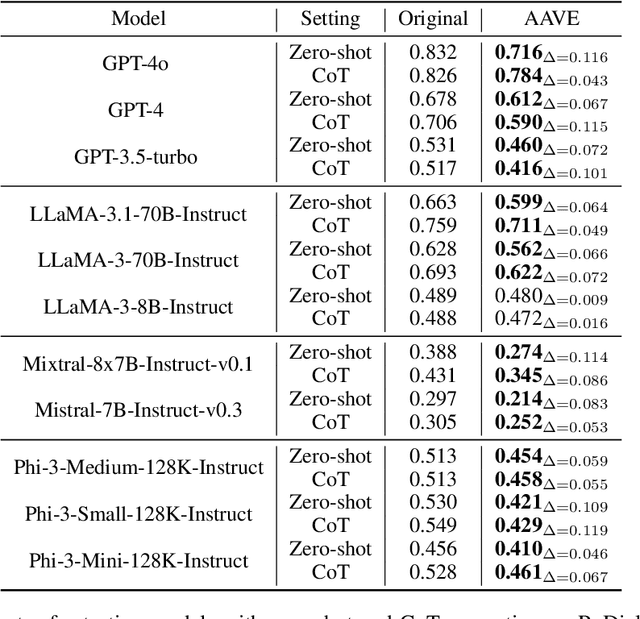
Abstract:Language is not monolithic. While many benchmarks are used as proxies to systematically estimate Large Language Models' (LLM) performance in real-life tasks, they tend to ignore the nuances of within-language variation and thus fail to model the experience of speakers of minority dialects. Focusing on African American Vernacular English (AAVE), we present the first study on LLMs' fairness and robustness to a dialect in canonical reasoning tasks (algorithm, math, logic, and comprehensive reasoning). We hire AAVE speakers, including experts with computer science backgrounds, to rewrite seven popular benchmarks, such as HumanEval and GSM8K. The result of this effort is ReDial, a dialectal benchmark comprising $1.2K+$ parallel query pairs in Standardized English and AAVE. We use ReDial to evaluate state-of-the-art LLMs, including GPT-4o/4/3.5-turbo, LLaMA-3.1/3, Mistral, and Phi-3. We find that, compared to Standardized English, almost all of these widely used models show significant brittleness and unfairness to queries in AAVE. Furthermore, AAVE queries can degrade performance more substantially than misspelled texts in Standardized English, even when LLMs are more familiar with the AAVE queries. Finally, asking models to rephrase questions in Standardized English does not close the performance gap but generally introduces higher costs. Overall, our findings indicate that LLMs provide unfair service to dialect users in complex reasoning tasks. Code can be found at https://github.com/fangru-lin/redial_dialect_robustness_fairness.git.
A Notion of Complexity for Theory of Mind via Discrete World Models
Jun 16, 2024Abstract:Theory of Mind (ToM) can be used to assess the capabilities of Large Language Models (LLMs) in complex scenarios where social reasoning is required. While the research community has proposed many ToM benchmarks, their hardness varies greatly, and their complexity is not well defined. This work proposes a framework to measure the complexity of ToM tasks. We quantify a problem's complexity as the number of states necessary to solve it correctly. Our complexity measure also accounts for spurious states of a ToM problem designed to make it apparently harder. We use our method to assess the complexity of five widely adopted ToM benchmarks. On top of this framework, we design a prompting technique that augments the information available to a model with a description of how the environment changes with the agents' interactions. We name this technique Discrete World Models (DWM) and show how it elicits superior performance on ToM tasks.
 Add to Chrome
Add to Chrome Add to Firefox
Add to Firefox Add to Edge
Add to Edge